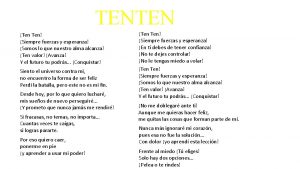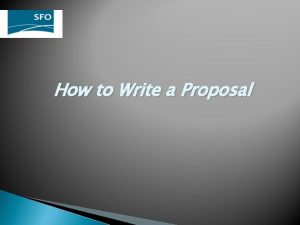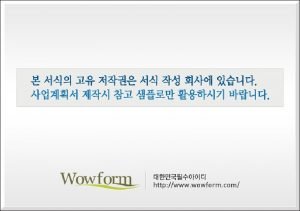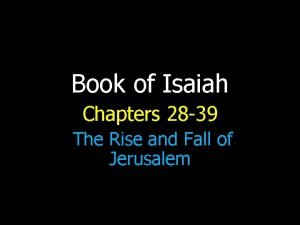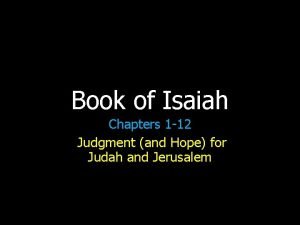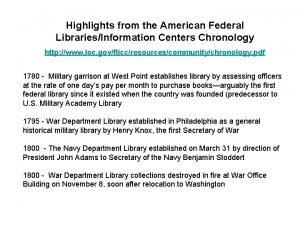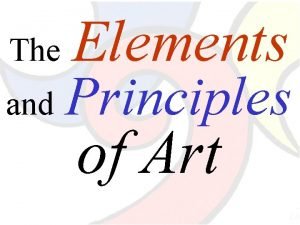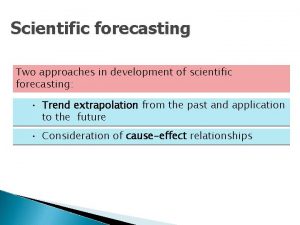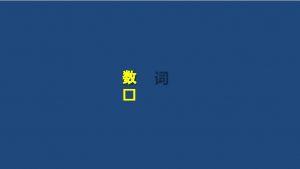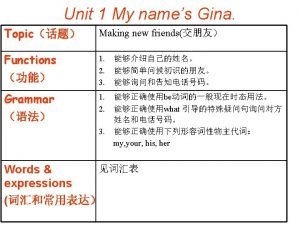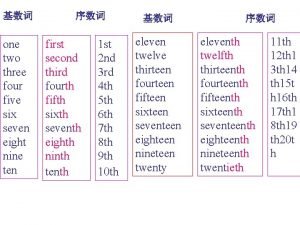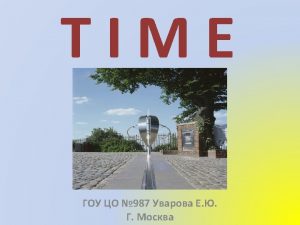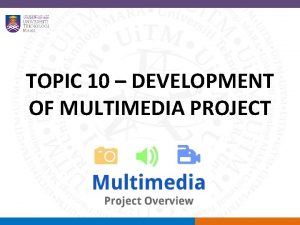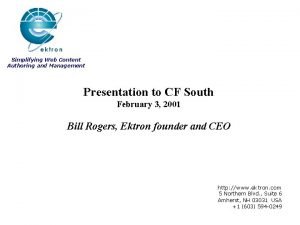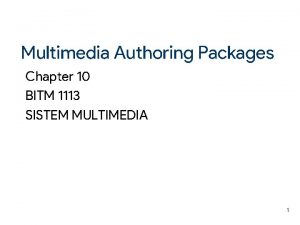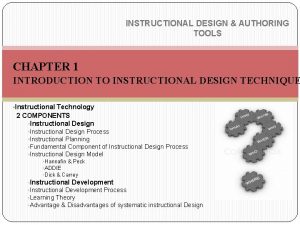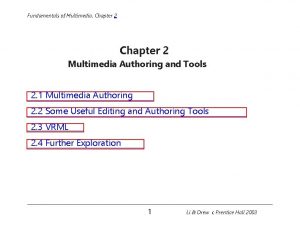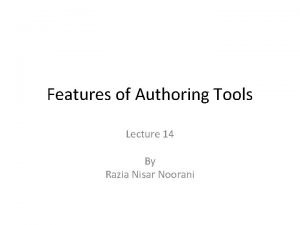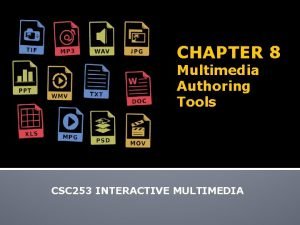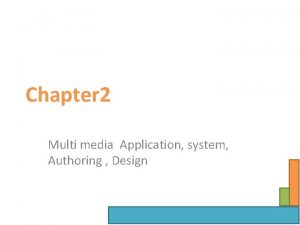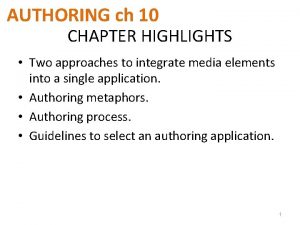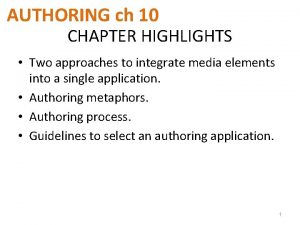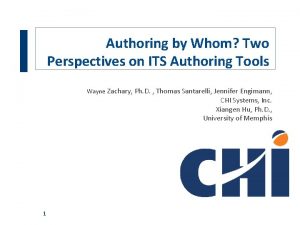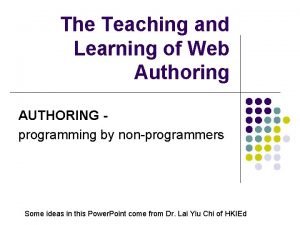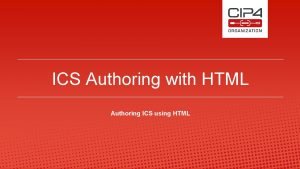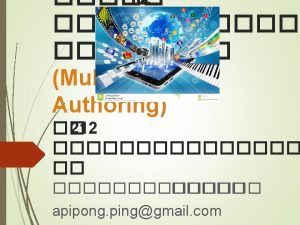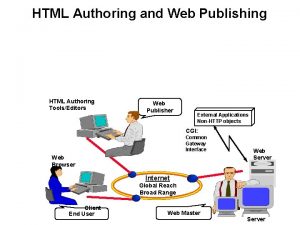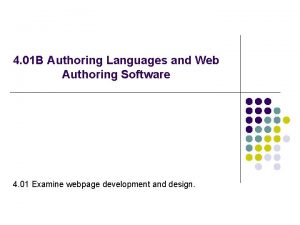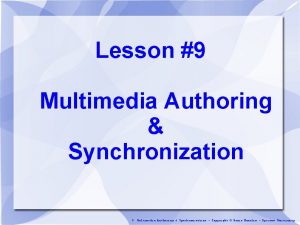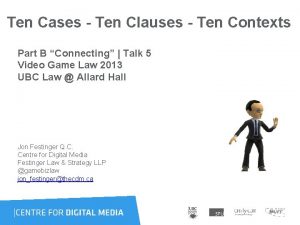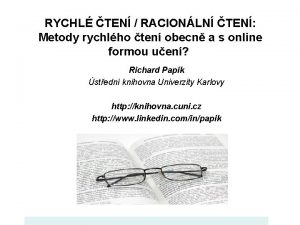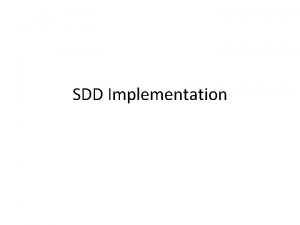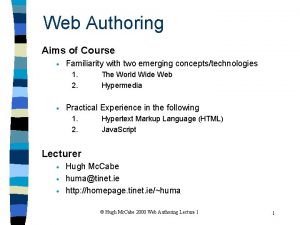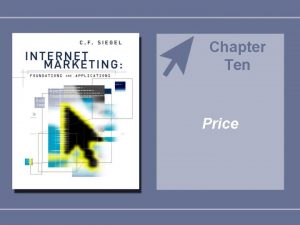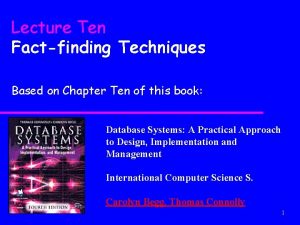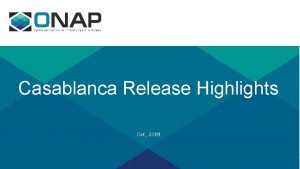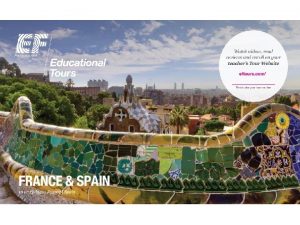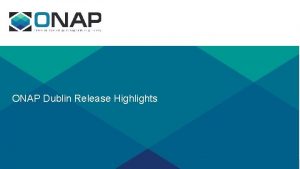CHAPTER TEN AUTHORING CHAPTER HIGHLIGHTS Two approaches to



























- Slides: 27

CHAPTER TEN AUTHORING

CHAPTER HIGHLIGHTS • Two approaches to integrate media elements into a single application. • Authoring metaphors. • Authoring process. • Guidelines to select an authoring application. 2

METHODS TO INTEGRATE MEDIA • Programming – Languages specify how the media is presented and user interactions carried out. – Requires command of the language. – Is time consuming. • Authoring – Applications specially designed to integrate and present media elements. – Developers can concentrate on design, interactivity, and functionality of the project. 3

AUTHORING APPLICATIONS • Software designed for creation of multimedia projects. • Applications are used to: – Assemble media elements – Synchronize content – Design user interface – Provide user interactivity. 4

AUTHORING METAPHORS • Authoring applications are grouped around three metaphors: – Card – Icon – Timeline. A metaphor is a comparison of one thing to another to enhance understanding. • Metaphors help orient developer to how the software organizes the media, sequences events, and presents final project. 5

CARD METAPHOR • Media is organized in sequential order on a stack of cards or slides. – Appropriate for static media that is normally experienced in sequence. • Cards have two layers: – Background layer contains shared elements. Foreground layer contains content specific to that card or slide. 6

CARD METAPHOR • Benefits of card layers. – Background content is created once which saves development time. – Common background layer provides consistent design. – File sizes are minimized by sharing background elements. 7

ICON METAPHOR • Icons define media and forms of interactivity. • Icons are placed on a flowline to create the application structure. – Each icon has a dialog box with properties and parameters identified by the developer. – Flowlines let developers visualize and adjust the structure of the application. • Branching routines add controls for user interaction. 8

ICON METAPHOR • Flowline is a graphical representation of the relationships between components of the application. 9

TIMELINE METAPHOR • Organizes media and interactivity as sequence of frames. – Each frame can have multiple layers. – Layers define the stacking order of the content to be displayed. • Appropriate for dynamic media as the media can by synchronized precisely over time. 10

TIMELINE METAPHOR • Popular timeline-based applications include Director and Flash. • Best used when animation or video is central to the application. 11

THE AUTHORING PROCESS A SERIES OF INTERRELATED TASKS FROM PROJECT DESIGN TO DELIVERY. 12

APPLICATION DESIGN • Authoring software supports the design process. – Outline view in Power. Point structures presentation. – Storyboard development is common in complex applications. • Storyboard is a series of screen sketches to guide development process. 13

IMPORTING CONTENT • Media is generally created in media-specific applications and imported into the authoring environment. – File formats for imported media are important. – Conversion utilities within the application are useful. 14

CREATE AND EDIT CONTENT • All authoring applications include some tools for creating and editing media content. For example: – Text adjustments to font size and color. – Paint tools to add shapes and edit image features. – Sound adjustment on volume, duration. – Animation changes to speed and direction. 15

INTEGRATION, SYNCHRONIZATION, and PLAYBACK • Techniques for integration are based on the metaphor (card, icon, timeline). • Sounds, animations and transitions must be synchronized to present a unified flow of information. • Playback of the content is often dependent on hardware factors. Timing controls can be established to ensure correct playback. 16

ESTABLISHING NAVIGATION • Authoring software can establish the order of the content on playback. • Basic navigation structures include: – Linear or sequential – Hierarchical – Networked – Conditional. 17

PROGRAMMING • Provides more flexibility and control. – For projects with extensive interactivity, custom features. • Two programming methods. – Script: series of commands specifying properties or behavior of an element in the project. • Commands are interpreted as the project is executed. – Icon: dialog boxes allow the developer to specify parameters for icon's use. • Does not require programming knowledge but does limit commands to icon parameters. 18

DATABASE SUPPORT • Some projects may require access to a collection of related files to store and retrieve user input. – Tutorials have databases of related facts to test comprehension. – User stores answers for future reference and scoring. • Authorware and Director applications offer an interface to a database. 19

PREVIEW, TEST, DEBUG • Projects are created in the development mode. – Necessary to preview the project as it will appear in the final product and test the components of the screen displays. – Authoring applications often have a preview mode to test the assembled project during development. • Debugger tools can identify errors in program code. 20

PROJECT DELIVERY • Projects are published so they play outside the authoring environment. • Two approaches to publishing. – Remote delivery • Store the application and data on a server for access through a network, most often the WWW. – Local installation • Application is installed and maintained on user’s device. 21

PROJECT DELIVERY • Remote delivery through a network connection. – Advantages: • Content revisions are managed by server database. • Wide market access • Developer can track users and determine patterns of usage. – Limitations: • Bandwidth restrictions may apply depending on user’s location or network service. • Browser applications are not uniformly compatible with all devices or applications. 22

PROJECT DELIVERY • Local installation on user device. – Advantages: • Project does not require constant connection to a network. • Developer can incorporate larger data files within the application. – Disadvantages: • Platform dependency. • Version control and critical updates are user dependent. • Inability to track demographics and patterns of use. 23

Local Delivery approaches • Projects for local delivery have two approaches to provide the application: – Project requires a separate player program to present the multimedia content. • Quick. Time, Flash, and Media. Player programs are free player downloads. – Project embeds the player in the multimedia project. • Larger files, but project is a stand-alone application. 24

CHOOSING AN AUTHORING APPLICATION • No single authoring tool is suitable for all projects. To select the right application: – Consider the subject (static or dynamic media). – Consider the media (source file formats compatible). – Consider delivery (where used, means of distribution). – Consider maintenance (expertise needed to revise content, frequent update cycles). 25

WRAP UP • Authoring applications – Integrate and synchronize media elements, add interface and interactivity, and deliver a project. • Authoring metaphors – Card, Icon, Timeline. • Applications have tools built in to support basic authoring functions. • Choosing an application depends on project needs. 26

KEY TERM CHECK UP 27
 Ten-twenty-thirty
Ten-twenty-thirty Ten ten siempre fuerzas y esperanza
Ten ten siempre fuerzas y esperanza Am i a 10/10
Am i a 10/10 Key highlight
Key highlight Proposal highlights
Proposal highlights Highlights memorandum
Highlights memorandum Investment highlights
Investment highlights Highlights from the book of isaiah
Highlights from the book of isaiah Highlights from the book of isaiah
Highlights from the book of isaiah Title for work immersion
Title for work immersion The passage highlights……
The passage highlights…… Drawing a face highlights what principle of design
Drawing a face highlights what principle of design Two approaches in corporate governance
Two approaches in corporate governance The two general approaches to forecasting are
The two general approaches to forecasting are The two dominant agile approaches are
The two dominant agile approaches are Two three four five six seven
Two three four five six seven Zero one two three four five six seven eight nine
Zero one two three four five six seven eight nine Three four five six seven
Three four five six seven Thirty five past four
Thirty five past four Stages of project in multimedia
Stages of project in multimedia 55x2080
55x2080 Free scorm editor
Free scorm editor Multimedia authoring system
Multimedia authoring system Instructional design authoring tools
Instructional design authoring tools Multimedia authoring metaphors
Multimedia authoring metaphors Features of authoring tools
Features of authoring tools Four main perspectives in multimedia authoring tools
Four main perspectives in multimedia authoring tools Designer multimedia authoring system
Designer multimedia authoring system

